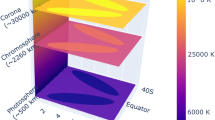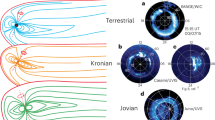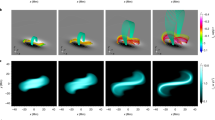Abstract
The structure of the solar atmosphere above and sluronllllding sunspots has been Plustrated in a previous article in NATURE.1 Silngle spots often lie at the centre of an apparent vortex resembling a terrestrial tornado or cycloriec soe i times nearly radial in form, more cornmmonly showing marked clockwise or counter-clockwise curvature. Bipolar spots (Fig. 1) are often suyrounded by a field of force similar to that of a bar magnet, though in rany eases the structure is verv different. I havo recenttly discssed the mature of these fields of force,2 but the evidence, which favoured a hydrodynamical rather than an electtro N S Fie. 1.-PIueld of forcE in thi hydrogeh st-rsosphcrr aurroundingt Ang. 21, M C4 T oe ibrditturt cf the, byclrOge-hr lnral Thase I reljlf siurroidig 111 Dor ite e.mgnetl poles. magnetie explanation, was inconclusive, especially in view of the prevalence of the bar margnet type so frequently assoEiated with bipolar spots. This seemed to point to an eleetronnagnetic origin, and the impossibility uf analysing adequately the structure of the hydrogen flocculi in thfese bipolar fields has greatly impeded progress.
This is a preview of subscription content, access via your institution
Access options
Subscribe to this journal
Receive 51 print issues and online access
$199.00 per year
only $3.90 per issue
Buy this article
- Purchase on Springer Link
- Instant access to full article PDF
Prices may be subject to local taxes which are calculated during checkout
Similar content being viewed by others
References
"Some New Possibilities in Solar Research," NATURE, July 3, 1926, Supp. p. 1.
"A Test of the Electromagnetic Theory of the Hydrogen Vortices surrounding Sunspots," Communications from the Mount Wilson Observatory, No. 93; Proc. National Academy of Sciences, 11, 691; 1925.
Contributions from the Mount Wilson Observatory, No. 109 Astrophysical Journal, 43. 347; 1916.
Contributions from the Mount Wilson Observatory, No. 26 Astrophysical Journal, 28. 100; 1908.
It should be clearly unlerstood, however, that Fig. 5 represents three successive stages in the inflow of the tip of a prominence, whereas in the cas illusrated in Fig. 4 the tip had already reached a point above the elee of th penumbra before the observations were begun. With a rather wile second slit, nearly the whole length of this curved flocculus (A to C) could be recorded in a single photogrsph, as shown in Fig. 3.
Astrophysical Journal, 36, 265; 1912.
"The Forms and Motions of the Solar Prominences," Pub. Yerkes Observatory, 3. part 4; 1925.
Memoirs Kodaikanal Observatory, 1, part 2; 106.
See Hale and Nicholson, "The Law of Sunspot Polarity," (Contributions from the Mount Wilson Observatory, No. 300; Astrophysical Journal, 62, 270; 1925.
"Sunspots as Magnets and the Periodic Reversal of their Polarity," NATURE, Jan. 19, 1924.
Author information
Authors and Affiliations
Rights and permissions
About this article
Cite this article
HALE, G. The Fields of Force in the Atmosphere of the Sun. Nature 119, 708–714 (1927). https://doi.org/10.1038/119708a0
Issue Date:
DOI: https://doi.org/10.1038/119708a0
This article is cited by
-
Magnetic and Velocity Field Topology in Active Regions of Descending Phase of Solar Cycle 23
Solar Physics (2020)
-
Flare-CME Models: An Observational Perspective (Invited Review)
Solar Physics (2015)
-
Role of Sunspot and Sunspot-Group Rotation in Driving Sigmoidal Active Region Eruptions
Solar Physics (2006)
-
The Alpha Effect and the Observed Twist and Current Helicity of Solar Magnetic Fields
Solar Physics (2006)
-
Analysis of electric current helicity in active regions on the basis of vector magnetograms
Solar Physics (1996)
Comments
By submitting a comment you agree to abide by our Terms and Community Guidelines. If you find something abusive or that does not comply with our terms or guidelines please flag it as inappropriate.



